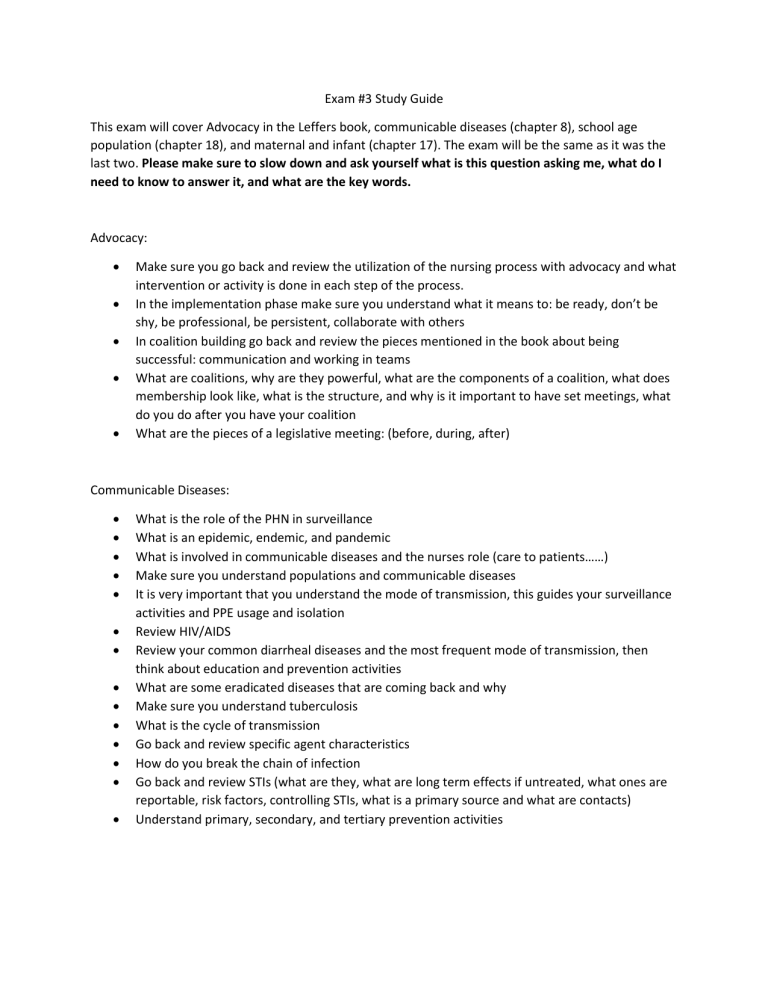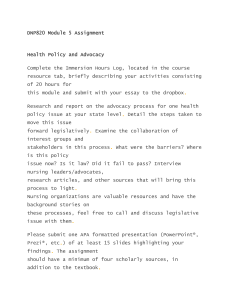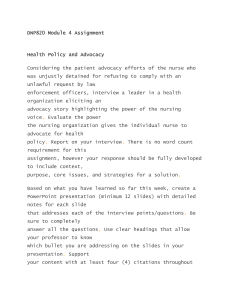
Exam #3 Study Guide This exam will cover Advocacy in the Leffers book, communicable diseases (chapter 8), school age population (chapter 18), and maternal and infant (chapter 17). The exam will be the same as it was the last two. Please make sure to slow down and ask yourself what is this question asking me, what do I need to know to answer it, and what are the key words. Advocacy: Make sure you go back and review the utilization of the nursing process with advocacy and what intervention or activity is done in each step of the process. In the implementation phase make sure you understand what it means to: be ready, don’t be shy, be professional, be persistent, collaborate with others In coalition building go back and review the pieces mentioned in the book about being successful: communication and working in teams What are coalitions, why are they powerful, what are the components of a coalition, what does membership look like, what is the structure, and why is it important to have set meetings, what do you do after you have your coalition What are the pieces of a legislative meeting: (before, during, after) Communicable Diseases: What is the role of the PHN in surveillance What is an epidemic, endemic, and pandemic What is involved in communicable diseases and the nurses role (care to patients……) Make sure you understand populations and communicable diseases It is very important that you understand the mode of transmission, this guides your surveillance activities and PPE usage and isolation Review HIV/AIDS Review your common diarrheal diseases and the most frequent mode of transmission, then think about education and prevention activities What are some eradicated diseases that are coming back and why Make sure you understand tuberculosis What is the cycle of transmission Go back and review specific agent characteristics How do you break the chain of infection Go back and review STIs (what are they, what are long term effects if untreated, what ones are reportable, risk factors, controlling STIs, what is a primary source and what are contacts) Understand primary, secondary, and tertiary prevention activities School Age Population Review Montana State immunization requirements What is school nursing What is the role of a school nurse and what does it involve What are activities of the school nurse School nurse functions What are some coordination efforts What are the four main supportive structures Understand the tenants of the Whole School, Whole Community, Whole Child framework Know what would fall under the pillars of the framework for the 21st century school nursing What are some interventions at the school age level Health screenings What are some episodic care issues school nurses might encounter Care coordination Care for children with disabilities Mental health issues in the school age population Advocacy and policy Health Planning for Maternal, Infant, and Child Why is health of children under 5 important Maternal mortality along with vulnerable populations Birth expectations Indicators of population health (maternal mortality) Top 5 leading causes of death for infants Global prevention efforts and burden Mortality of children under 5 and prevention Obesity, tobacco use and pregnancy Prematurity and the risks associated with it Home visiting and maternal health Evidence based programs




